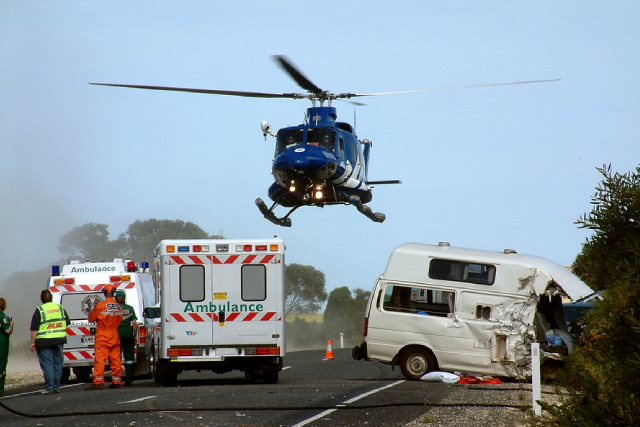
Medical evacuation might sound like a straightforward operation; someone is injured or ill, and they need to be transported quickly to a hospital. But when you start looking at all the moving parts behind the scenes, you realise it’s much more complex. From international coordination to specialist equipment and trained medical teams, every step must be executed with precision to ensure the patient’s safety and well-being.
Understanding how the medical evacuation process works can be incredibly helpful. In an emergency situation, whether at home or overseas, being prepared and knowing what to expect can make a stressful situation a little more manageable. This guide will walk you through each step of the process and show how these life-saving operations come together.
Step 1: Initial assessment of the patient’s condition
The medical evacuation journey begins with a thorough assessment of the patient’s medical condition. This is typically carried out by local medical personnel, first responders, or attending doctors. They evaluate the severity of the illness or injury and determine whether evacuation is necessary.
In some cases, the patient may be stable enough for ground transport to a nearby hospital. In more critical situations, such as severe trauma, heart attacks, strokes, or life-threatening infections, air evacuation might be the safest and quickest option to get to a facility that can provide the required level of care.
Step 2: Contacting a medical assistance provider
Once the need for evacuation is identified, the next step is to contact a provider specialising in Singapore medical assistance services. These organisations act as the central coordinator, arranging everything from medical staff and transport to international clearances and hospital admissions.
The provider will also begin liaising with all relevant parties: doctors at both the sending and receiving hospitals, airlines or aviation companies, and the patient’s family. They’ll ensure that the transfer process is medically justified and logistically feasible.
Step 3: Coordination and planning
This is where the process really gets going behind the scenes. The medical assistance team begins to coordinate every detail of the evacuation. This includes:
- Determining the best mode of transport (air ambulance, commercial flight with medical escort, or ground ambulance).
- Arranging visas, flight clearances, and any required paperwork for international travel.
- Preparing necessary medical equipment and medication.
- Assigning a qualified medical team to accompany the patient.
During this time, the patient’s condition is continuously monitored, and any changes are reported to the medical assistance team to reassess the urgency and mode of evacuation if needed.
Step 4: Medical preparation for transport
Before departure, the medical team preps the patient for travel. This includes administering stabilising treatment, securing intravenous lines, attaching monitors, and ensuring that the patient is safely positioned for the journey. For air transport, it’s especially important to assess how the change in altitude and pressure might affect the patient’s condition.
In Singapore, medical evacuation teams are often equipped with ICU-level facilities onboard air ambulances, ensuring the patient receives high-quality care throughout the journey. This is where choosing an experienced provider offering medical evacuation in Singapore makes all the difference.
Step 5: The journey – air or ground transport
With everything prepared, the patient is carefully moved onto the transport vehicle. Depending on the circumstances, this could be a fully equipped ambulance, a helicopter, or a fixed-wing aircraft.
Air ambulances are essentially flying hospitals staffed with doctors, nurses, and paramedics. Every piece of equipment on board is selected based on the patient’s condition, whether they need cardiac monitoring, oxygen support, or advanced life support.
If the evacuation involves commercial air travel, a medical escort may accompany the patient in a designated area of the plane, ensuring constant monitoring and care during the flight. This is common for stable patients who still require supervision.
Step 6: Arrival and handover at the receiving facility
Upon arrival, the medical team coordinates the transfer of the patient from the transport vehicle to the receiving hospital. This is a critical step that needs to be handled smoothly to avoid any delay in care. The medical handover includes:
- Providing the receiving hospital team with detailed notes and reports.
- Explaining any treatments or medication administered en route.
- Ensuring continuity of care by answering any questions the new team may have.
The goal is to make the transition seamless so the patient can immediately receive the next stage of treatment.
Step 7: Ongoing communication and support
Even after the patient is admitted to the hospital, the medical assistance provider continues to offer support. They update the patient’s family, liaise with insurers, and make sure any necessary follow-up arrangements, such as repatriation or further treatment, are in place.
This holistic approach ensures that patients and their families aren’t left to manage complex medical and logistical situations alone. In critical scenarios requiring urgent medical evacuation, having a trusted partner can be the difference between chaos and calm.
Conclusion
It’s not just about getting from Point A to Point B. It’s about coordinated, compassionate care every step of the way. While no one hopes to find themselves in a situation requiring a medical evacuation, being informed about the process can help reduce anxiety and ensure better outcomes. From assessment and coordination to expert transport and hospital handover, every stage is designed with patient safety at its core.
EMA Global offers medical evacuation, repatriation, and air ambulance services. With a team of experienced professionals and international reach, EMA Global is ready to support you in your most critical moments anytime, anywhere.

